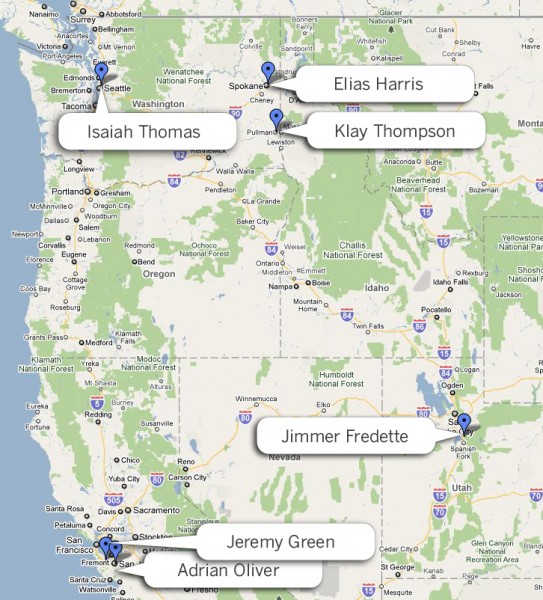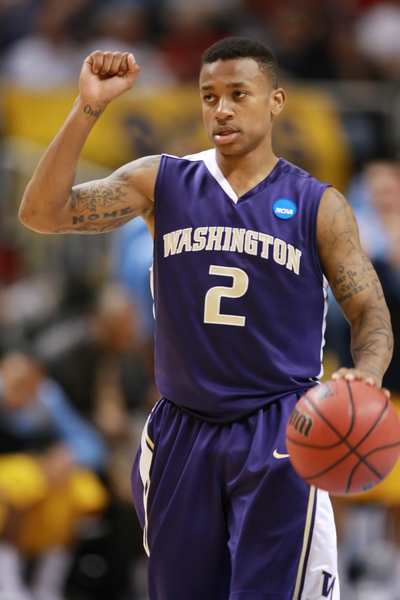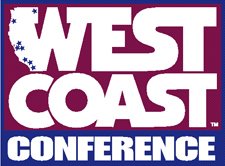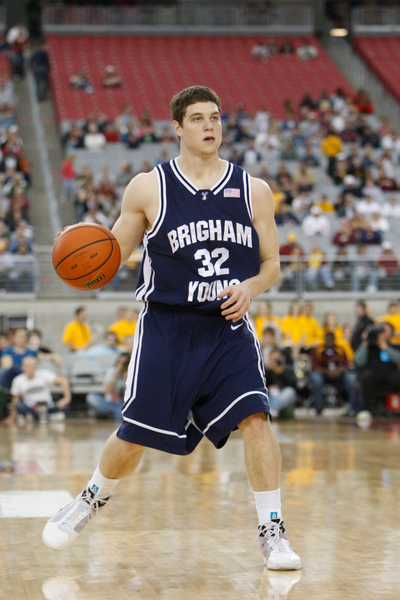Checking in on… the WCC
Posted by Brian Goodman on December 15th, 2010Michael Vernetti is the RTC correspondent for the West Coast Conference.
A Look Back
- It was a slow, after-finals week for most WCC teams, but the pace picks up considerably this weekend. Early-season top dogs Saint Mary’s and Portland cruised to expected wins – the Gaels by a score of 75-56 over UC Riverside at home and the Pilots in a closer-than-expected 71-64 win at Denver – and Gonzaga continued its slide against Top 25 teams, losing to Notre Dame in South Bend to fall to 4-5 for the first time in many people’s memory.
- Loyola-Marymount and San Francisco scored home wins, Santa Clara lost on the road to Pacific, Pepperdine fell in Fresno and San Diego snapped an eight-game losing streak with a 82-57 thrashing of Laverne.
- Player of the Week: Rob Jones, Saint Mary’s – Gaels coach Randy Bennett has said his goal with transfer forward Rob Jones is to turn him into a scoring leader, and Jones may have gotten the message this week with lines of 24 and 11 against UC Riverside following a 17 and 11 outing against Denver. Jones, who was a solid but unspectacular force in his first two years at San Diego, took on more responsibility for the Gaels in its need to replace the frontcourt scoring and rebounding punch of Omar Samhan and Ben Allen. He has shown signs of being able to surpass Allen’s production, lessening the pressure on Kenton Walker, Tim Williams and Mitchell Young to collectively fill Samhan’s shoes. Standing out in the UC Riverside stat sheet: Jones’ 6-9 mark from the three-point line.
Power Rankings
- Saint Mary’s (8-2): One of the knocks on Saint Mary’s so far this season is a lack of true road wins, with a 69-55 loss at San Diego State its only foray into an opponent’s gym. That could change before Christmas, as the Gaels travel to Las Cruces to face the New Mexico State Aggies next Thursday, following a December 18 matchup with Long Beach State in the Wooden Classic in Anaheim. New Mexico State (3-7) is a far cry from the NCAA team of last year, but the Aggies are still smarting from the 100-68 loss suffered in Moraga last November. They will do all they can to repay the Gaels’ rude hospitality.
- Portland (8-3): While they picked up their third true road win on Saturday, a 71-64 victory over Denver, the Pioneers (2-8) made the Portland Pilots work for it. Denver led by one at halftime before the Pilots’ three-point-shooting duo of Nemanja Mitrovic and Jared Stohl, aided by rebounding machine Luke Sikma, powered the Pilots down the stretch. Mitrovic, the game’s leading scorer with 18 points, made three three-pointers in a row to spark an 11-2 run in the game’s final minutes that sealed the win. Mitrovic and Stohl combined for 9-15 shooting from beyond the arc, while Sikma notched his fifth double-double of the year with 11 and ten.
- Loyola Marymount (6-5): The Lions are nursing a three-game home win streak, the latest victory being a 72-67 come-from-behind effort over South Dakota on December 11. The wins have come over lowly competition, including Cal Poly and Sacramento State, but the fun ends this coming Saturday, when the considerably tougher Florida State Seminoles roll into Gersten Pavilion. Some of Florida State’s wins in a 7-2 season have come over suspect teams like Mid-Continent and North Florida, but the ‘Noles recently topped Clemson 75-69 and have lost only to in-state rival Florida (55-51) and Big Ten power Ohio State and its dynamic freshman Jared Sullinger (58-48). You could say the bar will be raised considerably higher for Max Good’s revamped Lions, who have been improvising with the loss of stars Jarred DuBois and Ashley Hamilton and the slow rehabilitation of Edgar Garibay. New names such as freshmen Anthony Ireland, Godwin Akonji and Ayodeji Egbeyimi (call him “Deji”), have been finding their way alongside veterans Vernon Teel, Drew Viney and Larry Davis.
- Santa Clara (5-5): SC looked to be steadying itself with a 67-63 road win over cross-town rival San Jose State on Friday, but the wheels fell off when the Broncos went a little farther afield against Pacific in Stockton on Tuesday. Starting the unconventional lineup featuring Chris Cunningham in place of Marc Trasolini for the second straight game, the Broncos fell behind by as many as 21 points (60-39) late in the second half and lost by ten, 69-59. Pacific (6-4) has no signature wins this year and lost to Pepperdine last week, but handled Santa Clara easily. Kerry Keating has a chance to continue experimenting with his lineup on Friday, when the Broncos host Houston Baptist, but had better settle on his best troops before they face Washington State on Sunday.
- Gonzaga (4-5): The Zags found some balance in its not-as-close-as-it-looks 83-79 loss to Notre Dame on Saturday, but they’re still struggling to find a floor leader (did I hear the name “Bouldin” whispered in the wind?). Elias Harris had 19 points, Steven Gray 18 and Robert Sacre 16 for the Zags against Notre Dame, and those numbers are what the world was expecting this year. But even with strong production from its core players, the Zags found themselves trailing the Irish by 14 in the second half, with another rout seemingly in the works. Only a lethargic effort by Notre Dame down the stretch prevented that, and the Zags are struggling to find a steadying force in the backcourt to supplement their power players. Transfer Marquise Carter doesn’t look like the answer so far, and veteran Meech Goodson has not put a strong stamp on the team. With a breather Thursday against Lewis Clark State in Spokane, the Zags are thrust right back into the fire on Saturday with a game against Baylor in Arlington.
- San Francisco (4-5): A light week was good news for a team struggling to find healthy bodies, and the Dons rewarded themselves with a 50-48 overtime win over rugged Montana. Guard Cody Doolin, who went down in the Dons’ loss at Louisville last week, returned to help his teammates hold off the Grizzlies, but it was his backcourt mate Michael Williams who stole the show. Williams accounted for 23 points and 13 rebounds in the low-scoring affair, and was joined by Perris Blackwell with 12 and ten. The Dons will need efforts like those and much more as it travels to Seattle on Saturday to face streaking Washington.
- Pepperdine (4-8): The Waves racked up 27 turnovers in its 64-51 road loss to Fresno State. Conference POY candidate Keion Bell had eight of them. Pepperdine will hope to get back on track Saturday when it hosts UC-Irvine.
- San Diego (2-8): USD had something to celebrate with Monday’s 82-57 pasting of Laverne, and could overlook the fact that its first victory in nine tries came at the expense of a 3-4 NCAA Division-III squad that doesn’t grant athletic scholarships. Why quibble? Bill Grier may have found some answers with the second straight strong games from burly 6’11 center Chris Gabriel and transfer guard Darian Norris. Adding fuel to a small glow of hope for the Toreros was the play of freshman forward Trevor Fuller, who elicited some excitement as a star for Episcopal School of Dallas, but has mainly sat the bench for San Diego. Gabriel, Norris and sophomore Ken Rancifer scored 14 points each, while Fuller contributed six points in 17 minutes. Things might not be so cheery next week in Honolulu when the Toreros take on the likes of Baylor, Washington State or Mississippi State in the Diamond Head Classic.
A Look Ahead
This Saturday will be the broadest showcase for WCC teams in the current season. Some of the marquee matchups include Saint Mary’s vs. Long Beach State in the Wooden Classic in Anaheim; Gonzaga vs. Baylor in Arlington; Loyola vs. Florida State in Los Angeles; San Francisco vs. Washington in Seattle; and Portland vs. Portland State in – where else? – Portland (Portland State is the home team).





















































